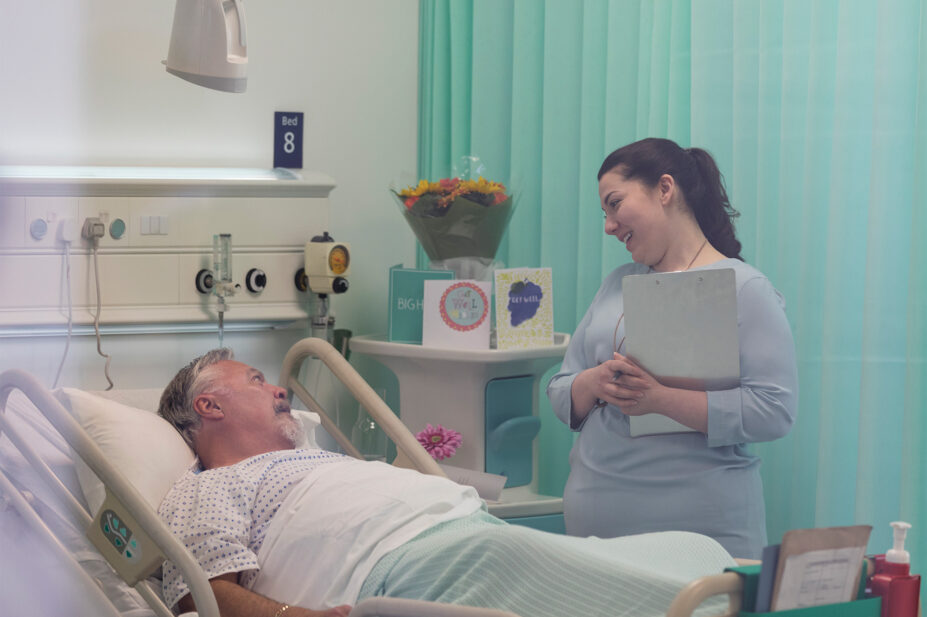
CAIA IMAGE/SCIENCE PHOTO LIBRARY
After reading this article, you should be able to:
- Describe the problems that can occur at transition of care;
- Understand the components of a safe transition of care;
- Be aware of the roles that pharmacy can play in supporting transition of care.
Introduction
The World Health Organization (WHO) defines transitions of care (ToC) as the various points where a patient moves to, or returns from, a particular physical location or makes contact with a healthcare professional for the purposes of receiving healthcare. This includes transitions between home, hospital, residential care settings and consultations with different healthcare providers in outpatient facilities1. The term ‘ToC’ encompasses the clinical aspects of care transfer and other factors, such as the preferences, experiences and needs of the patient.
ToC, including when patient movement occurs between wards in a hospital setting, is a recognised risk factor for medication-related harm2–4. When people move between care settings, their medication is often subject to change and these changes are not always clear to the patient, especially at discharge5,6. Patients may feel overwhelmed or confused by medication changes that have occurred during hospitalisation, and any discharge counselling they receive about their medication may not be fully understood because patients are often distracted, overloaded with information and eager to leave for home7. The patient’s primary healthcare provider may not be advised about changes to medication that have been made8. Such discontinuity of care and poor communication at hospital discharge can result in medication-related problems, adverse events and even readmissions9,10.
One 2021 study from the Netherlands found that 16% of readmissions are medication-related, of which 40% are potentially preventable11. Most of the medication errors involved in the potentially preventable readmissions were classified as non-adherence (35%) and prescribing errors (35%), followed by transition errors (30%). A UK study reported in 2018 that the incidence of hospital readmission associated with medication-related harm in older adults was 78 per 1,000 discharges10. This study estimated the cost to the NHS of post-discharge medication harm in older adults at £396m, of which over 90% is attributable to hospital readmissions10.
Guidance from the National Institute for Health and Care Excellence12, referencing a 2012 Royal Pharmaceutical Society (RPS) document13, noted that between 30% and 70% of patients have an error or unintentional change to their medicines when moving from one care setting to another. More recently, in 2020, a systematic review estimated that up to half of adults discharged from the hospital to the community experience at least one medication error or unintentional medication discrepancy, and one out of five adults discharged suffer an adverse drug event14. A modelling study examining how the digital transfer of a patient’s prescription information would affect patient safety estimated that, in England, a single digital prescribing record could reduce medication errors by between 10% and 50%, leading to between 18,000 and 913,000 fewer errors, and saving 4 to 22 lives annually15. Many studies have shown that problems at ToC involve reconciliation errors16, patient confusion5, inappropriate continuation of short-term medication17 and inadequate monitoring18.
This article will consider the work being done to reduce medicines related harm at ToC, the role of pharmacy teams and some considerations for pharmacy teams to integrate into their practice.
World Health Organization initiative
The WHO’s Global Patient Safety Challenge: Medication Without Harm, launched in 2017, focuses on improving medication safety by strengthening the systems for reducing medication errors and avoidable medication-related harm in three main areas19:
- High-risk situations (e.g. where the medication being used may be associated with a particularly high risk of harm);
- Polypharmacy, and;
- Transitions of care.
In 2019, the WHO urged countries to prioritise early and sustained action to reduce medication-related harm arising at transitions2.
In England, as part of the response to the WHO initiative, the secretary of state commissioned research into the prevalence and economic burden of medication errors in the NHS20. This resulted in work being done across England to improve medicines safety, including the nationally commissioned discharge medicines service (DMS). In 2021, a quality improvement guide published by the Royal College of Physicians (endorsed by the RPS) aimed to help organisations improve medication safety when patients leave hospital21. The suggestions from this guide are summarised in Box 121.
Box 1: Recommendations from the Royal College of Physicians for medication safety at hospital discharge
- Implement formal structured processes for medicines reconciliation when patients are being discharged from hospital;
- Partnership between patients, caregivers and healthcare professionals at hospital discharge;
- Prioritise patients at high risk of medication-related harm around hospital discharge;
- Implement collaborative medicines optimisation at hospital discharge;
- Improve the quality and availability of medication-related information at hospital discharge.
Evidence of interventions to reduce transition of care errors
Several systematic reviews have explored a range of interventions delivered by healthcare professionals, including pharmacy personnel, across the patient pathway both within a hospital setting and post-discharge22,23. These interventions have targeted patient counselling24–27, medication reconciliation activities25,28 and specific patient populations29.
However, a 2024 review examining hospital pharmaceutical services at ToC interfaces (such as medication reconciliation, medication analysis and medication management at admission, internal transition and discharge) identified a lack of consistent implementation of such services in high-income countries30.
The role of community pharmacy
Several studies have explored the positive benefits of community pharmacy teams reviewing patients post discharge from hospitals31–36. One important study, published in 2016, provided evidence to inform the introduction of the DMS within the community pharmacy setting in England37–39. This study showed that it is possible to transfer discharge information electronically from secondary care to allow community pharmacy teams to provide a follow-up consultation tailored to the patient’s need and it also indicated that patients may have lower rates of readmission and shorter hospital stays37. Another paper, which evaluated the discharge medicines review service provided by community pharmacists in Wales, suggested that the scheme was cost saving through reduced emergency attendances, hospital admissions and drug wastage40.
As part of the English DMS, NHS trusts will have considered eligibility criteria (high-risk patients or high-risk medicines) to help identify patients for referral from hospital, reflecting what is known about vulnerable patient groups (e.g. people taking five or more medicines) and specific medicine categories (e.g. anticoagulants, antiepileptics, anti-inflammatories) that may cause harm following transition from secondary to primary care38. The benefits of the DMS for paediatric patients have also been explored41.
Alongside the service delivered by community pharmacy teams, an additional approach to the management of discharge summaries has emerged through the introduction of clinical pharmacists in general practice in England. Therefore, a coordinated approach to the management of discharge summaries by community pharmacy teams and pharmacy teams working in general practice is required to avoid duplication of effort and to ensure joined-up care38. This opportunity for collaboration has been picked up in the primary care patient safety strategy42.
Best practice for pharmacy teams during transitions of care
Secondary care
Various actions by relevant pharmacy teams contribute to safer patient ToC43. In secondary care, medication reconciliation conducted at admission to hospital is the process of compiling a complete and accurate list of a person’s current medicines, comparing this information to the list of medicines prescribed on the drug chart, identifying any discrepancies, resolving them and recording the outcome. This involves various steps and access to different sources of medicines histories44. This information is best gathered within 24 hours of hospital admission. Further considerations are needed during the hospital admission if, for example, patients transition between an intensive care setting to a general ward, especially if different prescribing systems are in operation. Conducting a medication review on the intensive care unit prior to patient transfer and communicating medication changes and plans are particularly important risks that should be addressed45.
Medication reconciliation at discharge involves not just medicines the patient was taking prior to admission, but also the changes made to patients’ treatment plan during their hospital stay. Changes made to the medicines should be described in the discharge letter and communicated to the patient or carer in a way that they can comprehend the reasoning behind the changes. Such changes might include discontinuing a medicine the patient was taking prior to admission, continuing new medicines commenced during the hospital stay, and restarting a medicine prescribed previously and that was temporarily put on hold during the hospital stay. This communication with the patient may be undertaken, in the main, by pharmacy staff or nurses, with patients receiving patient-friendly ‘medicines list’, as well as a copy of the discharge letter. A checklist for patients has been designed to help make sure they have received the right information46. Referring the patient for the DMS so that their community pharmacy team can help reinforce this communication is an important part of the discharge process.
Primary care
Following discharge, patients should have a reconciled list of their medicines in their GP record within one week of the GP practice receiving the discharge letter, and before a prescription or new supply of medicines is issued12. Any discrepancies or changes should be carefully reviewed and resolved, and this may require the GP practice pharmacy team to query the information received with the discharging hospital.
In some geographical areas, general practice pharmacy teams may have access to the hospital’s electronic prescribing system and so be able to see the medication journey for their patient. If the discrepancy cannot be resolved in this manner, the query from the practice may be directed to the hospital speciality (e.g. consultant that the patient was admitted under, or to the hospital pharmacy medicines information department).
Community pharmacy teams believe they have a role in patients’ medication management post-discharge, although various barriers have been reported. These include: a lack of information transfer from hospitals; issues with interprofessional communication; time-pressure/workload and staff shortages; patients’ awareness/acceptance of the service; and other patient-related issues, such as a lack of health literacy47,48. As part of the discharge process, the referral of patients for a DMS or a discharge medicines review enables community pharmacy to work effectively with their pharmacy colleagues in general practice to support patients to improve outcomes, prevent harm and reduce readmissions. If new medicines have been commenced in hospital, the community pharmacist may also be able to provide further support via other commissioned services, such as the new medicines service, where this would be clinically appropriate and where the patient meets the eligibility criteria39.
Conclusion
Recognising the various gaps in the ToC process, pharmacy teams in both primary and secondary care, and in collaboration with other relevant staff, have an important role to play in helping to improve the safety and quality of patient care. In Australia, a stewardship framework approach has been recommended49, and there may be some aspects of this framework — such as shared decision-making regarding discharge medication planning and medication changes, and multidisciplinary cross-sector case-conferencing for high-risk and complex patients — that could be considered in the UK.
- 1.Transitions of care. World Health Organization. 2016. Accessed May 2025. https://iris.who.int/bitstream/handle/10665/252272/9789241511599-eng.pdf
- 2.Medication Safety in Transitions of Care. World Health Organization. 2019. Accessed May 2025. https://www.who.int/publications/i/item/WHO-UHC-SDS-2019.9#:~:text=Medication%20discrepancies%20impact%20almost%20every,related%20harm%20arising%20at%20transitions.
- 3.Bourne RS, Jennings JK, Panagioti M, Hodkinson A, Sutton A, Ashcroft DM. Medication-related interventions to improve medication safety and patient outcomes on transition from adult intensive care settings: a systematic review and meta-analysis. BMJ Qual Saf. 2022;31(8):609-622. doi:10.1136/bmjqs-2021-013760
- 4.Short A, McPeake J, Andonovic M, et al. Medication-related problems in critical care survivors: a systematic review. Eur J Hosp Pharm. 2023;30(5):250-256. doi:10.1136/ejhpharm-2023-003715
- 5.Knight DA, Thompson D, Mathie E, Dickinson A. ‘Seamless care? Just a list would have helped!’ Older people and their carer’s experiences of support with medication on discharge home from hospital. Health Expectations. 2011;16(3):277-291. doi:10.1111/j.1369-7625.2011.00714.x
- 6.Bagge M, Norris P, Heydon S, Tordoff J. Older people’s experiences of medicine changes on leaving hospital. Research in Social and Administrative Pharmacy. 2014;10(5):791-800. doi:10.1016/j.sapharm.2013.10.005
- 7.Mundell R, Jamieson D, Shaw G, Thomson A, Forsyth P. Patient Experiences of Community Pharmacy Medication Supply and Medicines Reconciliation at Hospital Discharge: A Pilot Qualitative Study. Pharmacy. 2024;12(2):66. doi:10.3390/pharmacy12020066
- 8.Uitvlugt EB, Siegert CEH, Janssen MJA, Nijpels G, Karapinar-Çarkit F. Completeness of medication-related information in discharge letters and post-discharge general practitioner overviews. Int J Clin Pharm. 2015;37(6):1206-1212. doi:10.1007/s11096-015-0187-z
- 9.Williams H, Edwards A, Hibbert P, et al. Harms from discharge to primary care: mixed methods analysis of incident reports. Br J Gen Pract. 2015;65(641):e829-e837. doi:10.3399/bjgp15x687877
- 10.Parekh N, Ali K, Stevenson JM, et al. Incidence and cost of medication harm in older adults following hospital discharge: a multicentre prospective study in the UK. Brit J Clinical Pharma. 2018;84(8):1789-1797. doi:10.1111/bcp.13613
- 11.Uitvlugt EB, Janssen MJA, Siegert CEH, et al. Medication-Related Hospital Readmissions Within 30 Days of Discharge: Prevalence, Preventability, Type of Medication Errors and Risk Factors. Front Pharmacol. 2021;12. doi:10.3389/fphar.2021.567424
- 12.Medicines optimisation: the safe and effective use of medicines to enable the best possible outcomes [NG5]. National Institute for Health and Care Excellence. 2015. Accessed May 2025. https://www.nice.org.uk/guidance/ng5
- 13.Keeping patients safe when they transfer between care providers – getting the medicines right. Royal Pharmaceutical Society. 2012. Accessed May 2025. https://www.rpharms.com/Portals/0/RPS%20document%20library/Open%20access/Publications/Keeping%20patients%20safe%20transfer%20of%20care%20report.pdf
- 14.Alqenae FA, Steinke D, Keers RN. Prevalence and Nature of Medication Errors and Medication-Related Harm Following Discharge from Hospital to Community Settings: A Systematic Review. Drug Saf. 2020;43(6):517-537. doi:10.1007/s40264-020-00918-3
- 15.Camacho EM, Gavan S, Keers RN, Chuter A, Elliott RA. Estimating the impact on patient safety of enabling the digital transfer of patients’ prescription information in the English NHS. BMJ Qual Saf. 2024;33(11):726-737. doi:10.1136/bmjqs-2023-016675
- 16.Kripalani S, Jackson AT, Schnipper JL, Coleman EA. Promoting effective transitions of care at hospital discharge: A review of key issues for hospitalists. Journal of Hospital Medicine. 2007;2(5):314-323. doi:10.1002/jhm.228
- 17.Moore C, Wisnivesky J, Williams S, McGinn T. Medical errors related to discontinuity of care from an inpatient to an outpatient setting. J Gen Intern Med. 2003;18(8):646-651. doi:10.1046/j.1525-1497.2003.20722.x
- 18.Forster AJ, Murff HJ, Peterson JF, Gandhi TK, Bates DW. Adverse drug events occurring following hospital discharge. J Gen Intern Med. 2005;20(4):317-323. doi:10.1111/j.1525-1497.2005.30390.x
- 19.Medication Without Harm – Global Patient Safety Challenge on Medication Safety. World Health Organization. 2017. Accessed May 2025. https://www.gims-foundation.org/wp-content/uploads/2017/05/WHO-Brochure-GPSC_Medication-Without-Harm-2017.pdf
- 20.Prevalence and economic burden of medication errors in the NHS in England. Policy Research Unit in Economic Evaluation of Health & Care Interventions . 2018. Accessed May 2025. https://www.bpsassessment.com/wp-content/uploads/2020/06/1.-Prevalence-and-economic-burden-of-medication-errors-in-the-NHS-in-England-1.pdf
- 21.Medication safety at hospital discharge Improvement guide and resource. Royal College of Physicians. 2021. Accessed May 2025. https://www.rcp.ac.uk/media/rr2iblxr/medication-safety-at-hospital-discharge-improvement-guide-and-resource.pdf
- 22.Weber C, Meyer-Massetti C, Schönenberger N. Pharmacist-led interventions at hospital discharge: a scoping review of studies demonstrating reduced readmission rates. Int J Clin Pharm. 2024;47(1):15-30. doi:10.1007/s11096-024-01821-y
- 23.Becker C, Zumbrunn S, Beck K, et al. Interventions to Improve Communication at Hospital Discharge and Rates of Readmission. JAMA Netw Open. 2021;4(8):e2119346. doi:10.1001/jamanetworkopen.2021.19346
- 24.Bonetti AF, Reis WC, Mendes AM, et al. Impact of Pharmacist‐led Discharge Counseling on Hospital Readmission and Emergency Department Visits: A Systematic Review and Meta‐analysis. Journal of Hospital Medicine. 2019;15(1):52-59. doi:10.12788/jhm.3182
- 25.Harris M, Moore V, Barnes M, Persha H, Reed J, Zillich A. Effect of pharmacy-led interventions during care transitions on patient hospital readmission: A systematic review. Journal of the American Pharmacists Association. 2022;62(5):1477-1498.e8. doi:10.1016/j.japh.2022.05.017
- 26.Tomlinson J, Cheong VL, Fylan B, et al. Successful care transitions for older people: a systematic review and meta-analysis of the effects of interventions that support medication continuity. Age and Ageing. 2020;49(4):558-569. doi:10.1093/ageing/afaa002
- 27.Varghese S, Hahn-Goldberg S, Deng Z, et al. Medication Supports at Transitions Between Hospital and Other Care Settings: A Rapid Scoping Review. PPA. 2022;Volume 16:515-560. doi:10.2147/ppa.s348152
- 28.Mekonnen AB, McLachlan AJ, Brien J anne E. Pharmacy-led medication reconciliation programmes at hospital transitions: a systematic review and meta-analysis. J Clin Pharm Ther. 2016;41(2):128-144. doi:10.1111/jcpt.12364
- 29.Weeda E, Gilbert RE, Kolo SJ, et al. Impact of Pharmacist-Driven Transitions of Care Interventions on Post-hospital Outcomes Among Patients With Coronary Artery Disease: A Systematic Review. Journal of Pharmacy Practice. 2021;36(3):668-678. doi:10.1177/08971900211064155
- 30.Stoll JT, Weidmann AE. Development of hospital pharmacy services at transition of care points: a scoping review. Eur J Hosp Pharm. 2024;32(2):106-112. doi:10.1136/ejhpharm-2023-003836
- 31.Hockly M, Williams S, Allen M. Transfer of care – a randomised control trial investigating the effect of sending the details of patients’ discharge medication to their community pharmacist on discharge from hospital. International Journal of Pharmacy Practice. 2017;26(2):174-182. doi:10.1111/ijpp.12364
- 32.Nazar H, Nazar Z, Portlock J, Todd A, Slight SP. A systematic review of the role of community pharmacies in improving the transition from secondary to primary care. Brit J Clinical Pharma. 2015;80(5):936-948. doi:10.1111/bcp.12718
- 33.Lussier ME, Evans HJ, Wright EA, Gionfriddo MR. The impact of community pharmacist involvement on transitions of care: A systematic review and meta-analysis. Journal of the American Pharmacists Association. 2020;60(1):153-162.e5. doi:10.1016/j.japh.2019.07.002
- 34.Wilcock M, Sibley A, Blackwell R, Kluettgens B, Robens S, Bastian L. Involving community pharmacists in transfer of care from hospital: Indications of reduced 30-day hospital readmission rates for patients in Cornwall. International Journal of Pharmacy Practice. 2020;28(4):405-407. doi:10.1111/ijpp.12603
- 35.Mantzourani E, Nazar H, Phibben C, et al. Exploring the association of the discharge medicines review with patient hospital readmissions through national routine data linkage in Wales: a retrospective cohort study. BMJ Open. 2020;10(2):e033551. doi:10.1136/bmjopen-2019-033551
- 36.Lapointe-Shaw L, Bell CM, Austin PC, et al. Community pharmacy medication review, death and re-admission after hospital discharge: a propensity score-matched cohort study. BMJ Qual Saf. 2019;29(1):41-51. doi:10.1136/bmjqs-2019-009545
- 37.Nazar H, Brice S, Akhter N, et al. New transfer of care initiative of electronic referral from hospital to community pharmacy in England: a formative service evaluation. BMJ Open. 2016;6(10):e012532. doi:10.1136/bmjopen-2016-012532
- 38.NHS Discharge Medicines Service – Essential Service. Toolkit for pharmacy staff in community, primary and secondary care. NHS England and NHS Improvement. 2020. Accessed May 2025. https://www.england.nhs.uk/wp-content/uploads/2021/01/B0366-discharge-medicines-toolkit.pdf
- 39.Discharge Medicines Service. Community Pharmacy England. 2024. Accessed May 2025. https://cpe.org.uk/national-pharmacy-services/essential-services/discharge-medicines-service/
- 40.Evaluation of the discharge medicines review service . Welsh Institute for Health and Social Care. 2014. Accessed May 2025. https://cpwales.org.uk/evaluation-of-the-dmr-service-d1/
- 41.Trivedi A, Bhatti A, Patel B, Patel M. What’s age got to do with it? A study of the implementation of the discharge medicines service for paediatric patients. International Journal of Pharmacy Practice. 2024;32(3):229-236. doi:10.1093/ijpp/riae012
- 42.Primary care patient safety strategy. NHS England. 2025. Accessed May 2025. https://www.england.nhs.uk/long-read/primary-care-patient-safety-strategy/#appendix-2-summary-of-national-patient-safety-commitments
- 43.Medicines reconciliation and medication history. Royal Pharmaceutical Society. 2025. Accessed May 2025. https://www.rpharms.com/resources/pharmacy-guides/medicines-reconciliation-and-medication-history
- 44.How to perform accurate medicines reconciliation. Pharmaceutical Journal. Published online 2023. doi:10.1211/pj.2023.1.191429
- 45.Bourne RS, Phipps DL, Jennings JK, et al. Medication safety for intensive care patients transferring to a hospital ward: A Hierarchical Task Analysis. Human Factors in Healthcare. 2022;2:100030. doi:10.1016/j.hfh.2022.100030
- 46.Using medicines safely when you leave hospital. Royal College of Physicians. 2022. Accessed May 2025. https://www.rcp.ac.uk/media/rhrprzki/cqid_qips_medicines_safety_checklist_a4-final_0.pdf
- 47.Bailey MR, Hattingh L, Percival M, Ndukwe H. A qualitative study exploring community pharmacists’ perceptions and experiences with information transfer from Queensland health hospitals during patients’ transitions of care. International Journal of Pharmacy Practice. 2025;33(2):205-210. doi:10.1093/ijpp/riaf011
- 48.Khayyat SM, Nazar H. Qualitative investigation of barriers to providing an electronic hospital to community pharmacy referral service for discharged patients. Obiora OL, ed. PLoS ONE. 2023;18(3):e0283836. doi:10.1371/journal.pone.0283836
- 49.Elliott RA, Angley M, Criddle DT, Emadi F, Liu S, Penm J. Editorial: Achieving safe medication management during transitions of care from hospital: time for a stewardship approach. Aust Prescr. 2024;47(4):106-108. doi:10.18773/austprescr.2024.034


